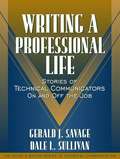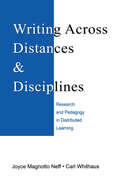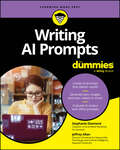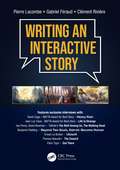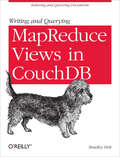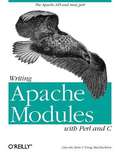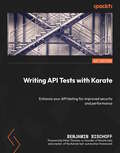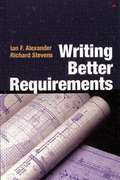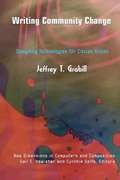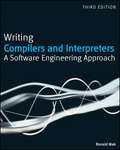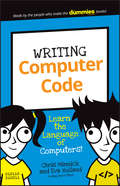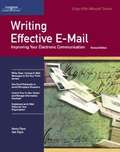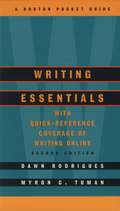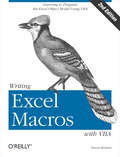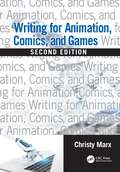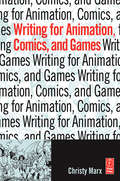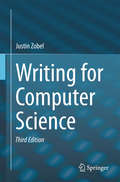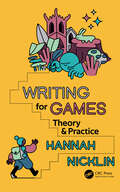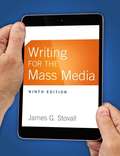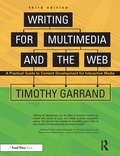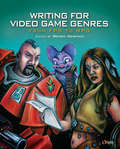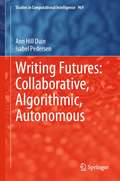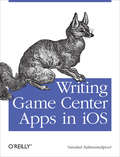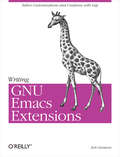- Table View
- List View
Writing a Professional Life: Stories of Technical Communicators On and Off the Job
by Gerald J. Savage Dale L. SullivanThis is the first collection of narratives by practicing technical communicators telling their own personal stories about the workplace and their lives on the job. The authors portray a wide range of jobs: writers, editors, interface designers, marketing writers, and trainers working in 9 different technical fields, including software, R&D, engineering , medicine, transportation, and telecommunications. The stories vividly demonstrate the unique power of narrative as a teaching and learning tool. Unlike fabricated cases, these real-life narratives show new and veteran technical writers at work on the job, dealing with tasks, clients, and co-workers, and revealing their insights, values, and attitudes about their work. The stories also show the skills required in the profession and the ethical and other issues raised in the course of the workday. For anyone interested in technical communication and professional writing.
Writing Across Distances and Disciplines: Research and Pedagogy in Distributed Learning
by Joyce Magnotto Neff Carl WhithausWriting Across Distances and Disciplines addresses questions that cross borders between onsite, hybrid, and distributed learning environments, between higher education and the workplace, and between distance education and composition pedagogy. This groundbreaking volume raises critical issues, clarifies key terms, reviews history and theory, analyzes current research, reconsiders pedagogy, explores specific applications of WAC and WID in distributed environments, and considers what business and education might teach one another about writing and learning. Exploring the intersection of writing across the curriculum, composition studies, and distance learning , it provides an in-depth look at issues of importance to students, faculty, and administrators regarding the technological future of writing and learning in higher education.
Writing AI Prompts For Dummies
by Stephanie Diamond Jeffrey AllanLearn the art of writing effective AI prompts and break into an exciting new career field Unlock the full power of generative AI with Writing AI Prompts For Dummies, a comprehensive guide that will teach you how to confidentially write effective AI prompts. Whether it's text, images, or even videos and music you're aiming to create, this book provides the foundational knowledge and practical strategies needed to produce impressive results. Embark on a journey of discovery with Writing AI Prompts For Dummies and learn how to: Craft AI prompts that produce the most powerful results. Navigate the complexities of different AI platforms with ease. Generate a diverse range of content, from compelling narratives to stunning visuals. Refine AI-generated output to perfection and integrate that output effectively into your business or project. This resource is brimming with expert guidance and will help you write AI prompts that achieve your objectives. Whether you're a marketer, educator, artist, or entrepreneur, Writing AI Prompts For Dummies is your indispensable guide for leveraging AI to its fullest potential. Get ready to harness the power of artificial intelligence and spark a revolution in your creative and professional efforts.
Writing an Interactive Story
by Pierre Lacombe Gabriel Feraud Clement RiviereVideo games have become the world's largest leading cultural product. Though disputed in the past, the narrative qualities of video games have finally secured distinction in the realm of art. This is especially true for interactive games. Writing an Interactive Story will help the reader in navigating the creation process of interactive scripts, in addition to discovering behind the scenes narrative choices of renowned games, and will help you to harness your inner creativity. Guided by master interactive scriptwriters, the text presents its content in the form of a unique writing workshop. With interactive game writing, the player becomes the star of the work. Thanks to this method of storytelling, the morals of the game become resonant. This is because the weight of the narrative’s choices and consequences rest fully upon the player. It's the ultimate narrative. Whether you are a video game enthusiast, student, or professional, discover how to create a more immersive personalized experience than ever before and give your players the opportunity to write their own destiny through their choices. The methods, strategies, and secrets of this new art await you. Features exclusive interviews with: David Cage – BAFTA Award for Best Story – Heavy Rain Jean-Luc Cano - BAFTA Award for Best Story – Life Is Strange Joe Penny, David Bowman – Telltale’s The Wolf Among Us, The Walking Dead Benjamin Diebling – Beyond Two Souls, Detroit: Become Human Erwan Le Breton – Ubisoft Thomas Veauclin– The Council Fibre Tigre – Out There
Writing and Querying MapReduce Views in CouchDB
by Bradley HoltIf you want to use CouchDB to support real-world applications, you'll need to create MapReduce views that let you query this document-oriented database for meaningful data. With this short and concise ebook, you'll learn how to create a variety of MapReduce views to help you query and aggregate data in CouchDB's large, distributed datasets. You'll get step-by-step instructions and lots of sample code to create and explore several MapReduce views through the course of the book, using an example database you construct. To work with these different views, you'll learn how to use the Futon web administration console and the cURL command line tool that come with CouchDB. Learn how the Map and Reduce steps work independently and together to index your data Use the example database to create several temporary views based on different criteria Discover the uses of Map and Reduce JavaScript functions Convert your temporary views to permanent views within a design document Learn several options for querying the data within your views Limit the number of results returned, skip some results, or reverse the order of the output Group your results by exact keys or by parts of keys Bradley Holt, co-founder of the creative services firm Found Line, is a web developer and entrepreneur ten years of PHP and MySQL experience. He began using CouchDB before the release of version 1.0. Bradley is an active member of the PHP community, and can be reached at bradley-holt.com.
Writing Apache Modules with Perl and C
by Doug Maceachern Lincoln SteinThis guide to web programming shows how to extend the capabilities of the Apache web server. It explains the design of Apache, mod_perl, and the Apache API, then demonstrates how to use them to rewrite CGI scripts, filter HTML documents on the server-side, enhance server log functionality, convert file formats on the fly, and more.
Writing API Tests with Karate: Enhance your API testing for improved security and performance
by Benjamin Bischoff Peter ThomasUnlock the full potential of Karate with this comprehensive guide to effortlessly setup, write, run, optimize, and report test resultsPurchase of the print or Kindle book includes a free PDF eBookKey FeaturesExplore the capabilities of the Karate framework for effective software testingLearn how to integrate Karate tests into projects and CI/CD pipelinesExplore lesser-known Karate modules such as Karate UI and Karate GatlingBook DescriptionSoftware in recent years is moving away from centralized systems and monoliths to smaller, scalable components that communicate with each other through APIs. Testing these communication interfaces is becoming increasingly important to ensure the security, performance, and extensibility of the software. A powerful tool to achieve safe and robust applications is Karate, an easy-to-use, and powerful software testing framework. In this book, you'll work with different modules of karate to get tailored solutions for modern test challenges. You'll be exploring interface testing, UI testing as well as performance testing. By the end of this book, you'll be able to use the Karate framework in your software development lifecycle to make your APIs and applications robust and trustworthy.What you will learnUnderstand the basic concepts of Karate and its functionalityIntegrate and use it effectively to solve your testing needsExtend Karate and customize its functionality for your use casesExplore different testing methods and their use casesRun your tests to check the software development lifecycleGet to know more about Karate's UI and performance test approachesWho this book is forThis book is for QA engineers and developers who are familiar with APIs and want to make them safer and more secure by applying automated tests with the help of a lightweight and modern framework - Karate.
Writing Better Requirements
by Richard Stevenson Ian F. AlexanderIf you are involved in the systems engineering process in any company, you will learn how to write requirements to get the system you want.
Writing Community Change: Designing Technologies for Citizen Action
by Jeffrey T. GrabillA book on writing for community change by use of information technology.
Writing Compilers and Interpreters
by Ronald MakLong-awaited revision to a unique guide that covers both compilers and interpreters Revised, updated, and now focusing on Java instead of C++, this long-awaited, latest edition of this popular book teaches programmers and software engineering students how to write compilers and interpreters using Java. You?ll write compilers and interpreters as case studies, generating general assembly code for a Java Virtual Machine that takes advantage of the Java Collections Framework to shorten and simplify the code. In addition, coverage includes Java Collections Framework, UML modeling, object-oriented programming with design patterns, working with XML intermediate code, and more.
Writing Computer Code: Learn the Language of Computers!
by Eva Holland Chris MinnickA technology book for kids! Learning how to code can be like learning a foreign language.This book serves as an excellent guide to help you start writing in the odd-looking languages that make the web work. Follow simple steps as you work with real code to build your own web robots. Create your robot--write code that builds your robot's body and structure Give your bot some style--add code lines that customize your robot's color and shape Get your robot moving--finish off your robot with code that teaches it how to dance Technology Requirements: Hardware - PC or tablet with Internet connection running Windows 7 or higher or Mac with Internet connection running Mac OS X 10.7 or higher Software - Web browser to access JSFiddle.net: Google ChromeTM, Mozilla Firefox, Apple Safari, Microsoft Edge, or Microsoft Internet Explorer version 9.0 or higher
Writing Effective E-Mail: Improving Your Electronic Communication
by Nancy Flynn Tom FlynnThe revised edition of Writing Effective E-Mail includes an added emphasis on how to avoid workplace disasters such as lost sales, customer service nightmares--and in the worst cases--lawsuits and financial losses, triggered by careless or poorly written e-mails. This book will also guide you in writing a comprehensive and effective e-mail policy for your organization.
Writing Essentials: A Norton Pocket Guide
by Dawn Rodriguez Myron C. TumanWriting Essentials combines the essentials of grammar, punctuation, mechanics, and documentation with practical suggestions for writing online.<P> From online prewriting, drafting, group workshopping, revising, and editing, to database searching, navigating the Internet, documenting online sources, and designing documents, Writing Essentials offers practical, hands-on advice for using computers throughout the writing process.
Writing Excel Macros with VBA
by Steven RomanNewly updated for Excel 2002, Writing Excel Macros with VBA, 2nd Edition provides Excel power-users, as well as programmers who are unfamiliar with the Excel object model, with a solid introduction to writing Visual Basic for Applications (VBA) macros and programs for Excel. In particular, the book focuses on:The Visual Basic Editor and the Excel VBA programming environment. Excel features a complete, state-of-the-art integrated development environment for writing, running, testing, and debugging VBA macros. The VBA programming language, the same programming language used by the other applications in Microsoft Office XP and 2000, as well as by the retail editions of Visual Basic 6.0. The Excel object model, including new objects and new members of existing objects in Excel 2002. Excel exposes nearly all of its functionality through its object model, which is the means by which Excel can be controlled programmatically using VBA. While the Excel object model, with 192 objects, is the second largest among the Office applications, you need to be familiar with only a handful of objects to write effective macros. Writing Excel Macros focuses on these essential objects, but includes a discussion of many more objects as well. Writing Excel Macros with VBA, 2nd Edition is written in a terse, no-nonsense manner that is characteristic of Steven Roman's straightforward, practical approach. Instead of a slow-paced tutorial with a lot of handholding, Roman offers the essential information about Excel VBA that you must master to write macros effectively. This tutorial is reinforced by interesting and useful examples that solve common problems you're sure to have encountered. Writing Excel Macros with VBA, 2nd Edition is the book you need to delve into the basics of Excel VBA programming, enabling you to increase your power and productivity.
Writing Excel Macros with VBA, 2nd Edition
by Steven RomanNewly updated for Excel 2002, Writing Excel Macros with VBA, 2nd Edition provides Excel power-users, as well as programmers who are unfamiliar with the Excel object model, with a solid introduction to writing Visual Basic for Applications (VBA) macros and programs for Excel. In particular, the book focuses on: * The Visual Basic Editor and the Excel VBA programming environment. Excel features a complete, state-of-the-art integrated development environment for writing, running, testing, and debugging VBA macros. The VBA programming language, the same programming language used by the other applications in Microsoft Office XP and 2000, as well as by the retail editions of Visual Basic 6.0. The Excel object model, including new objects and new members of existing objects in Excel 2002. Excel exposes nearly all of its functionality through its object model, which is the means by which Excel can be controlled programmatically using VBA. While the Excel object model, with 192 objects, is the second largest among the Office applications, you need to be familiar with only a handful of objects to write effective macros. Writing Excel Macros focuses on these essential objects, but includes a discussion of many more objects as well. Writing Excel Macros with VBA, 2nd Edition is written in a terse, no-nonsense manner that is characteristic of Steven Roman's straightforward, practical approach. Instead of a slow-paced tutorial with a lot of handholding, Roman offers the essential information about Excel VBA that you must master to write macros effectively. This tutorial is reinforced by interesting and useful examples that solve common problems you're sure to have encountered. Writing Excel Macros with VBA, 2nd Edition is the book you need to delve into the basics of Excel VBA programming, enabling you to increase your power and productivity.
Writing for Animation, Comics, and Games
by Christy MarxThis second edition of Writing for Animation, Comics, and Games expounds on the previous edition with more information on how to construct narratives for these three forms of visual storytelling media. Christy Marx’s book offers an in-depth look into scriptwriting and how to break into each of the featured industries. The text goes into detail on visual storytelling: how to compose exterior storytelling (animation, games) and interior/exterior storytelling (comics and graphic novels); as well as considerations for non-linear videogames. The advice within these pages can be used to build a transmedia career across animation, comics, graphic novels, and videogames. Key Features An insider's perspective on career rules of the road on writing for comics, videogames, and animation Written for beginners and professionals alike A nuts-and-bolts guide to script formats, terminology, networking, and valuable advice on writing for each medium Author Bio Based in Northern California, Christy Marx is an award-winning writer, story editor, TV series developer, game designer, and narrative designer. Her many credits include Babylon 5; Captain Power and Soldiers of the Future; The Twilight Zone; G.I. Joe; Jem and the Holograms; Spider-Man; He-Man; X-Men Evolution; Teenage Mutant Ninja Turtles; Conan the Adventurer; Birds of Prey; Amethyst; The Sisterhood of Steel; Sierra On-Line adventure games; PC, MMO, and console games; Zynga mobile games; and more. For full credits, visit www.christymarx.com.
Writing for Animation, Comics, and Games
by Christy MarxWriting for Animation, Comics, and Games explains the practical aspects of creating scripts for animation, comics, graphic novels, and computer games. It details how you can create scripts that are in the right industry format, and follow the expected rules for you to put your best foot forward to help you break-in to the trade. This book explains approaches to writing for exterior storytelling (animation, games); interior/exterior storytelling (comics and graphic novels), as well as considerations for non-linear computer games in the shortest, pithiest, and most economical way. The author offers insider's advice on how you can present work as professional, how to meet deadlines, how visual writing differs from prose, and the art of collaboration.
Writing for Computer Science
by Justin ZobelAll researchers need to write or speak about their work, and to have research that is worth presenting. Based on the author's decades of experience as a researcher and advisor, this third edition provides detailed guidance on writing and presentations and a comprehensive introduction to research methods, the how-to of being a successful scientist. Topics include: · Development of ideas into research questions; · How to find, read, evaluate and referee other research; · Design and evaluation of experiments and appropriate use of statistics; · Ethics, the principles of science and examples of science gone wrong. Much of the book is a step-by-step guide to effective communication, with advice on: · Writing style and editing; · Figures, graphs and tables; · Mathematics and algorithms; · Literature reviews and referees' reports; · Structuring of arguments and results into papers and theses; · Writing of other professional documents; · Presentation of talks and posters. Written in an accessible style and including handy checklists and exercises, Writing for Computer Science is not only an introduction to the doing and describing of research, but is a valuable reference for working scientists in the computing and mathematical sciences.
Writing for Games: Theory and Practice
by Hannah NicklinFocussing on the independent videogames sector, this book provides readers with a vocabulary to articulate and build their games writing practice; whether studying games or coming to games from another storytelling discipline. Writing for Games offers resources for communication, collaboration, reflection, and advocacy, inviting the reader to situate their practice in a centuries-long heritage of storytelling, as well as considering the material affordances of videogames, and the practical realities of working in game development processes. Structured into three parts, Theory considers the craft of both games and writing from a theoretical perspective, covering vocabulary for both game and story practices. Case Studies uses three case studies to explore the theory explored in Part 1. The Practical Workbook offers a series of provocations, tools and exercises that give the reader the means to refine and develop their writing, not just for now, but as a part of a life-long practice. Writing for Games: Theory and Practice is an approachable and entry-level text for anyone interested in the craft of writing for videogames. Hannah Nicklin is an award-winning narrative and game designer, writer, and academic who has been practising for nearly 15 years. She works hard to create playful experiences that see people and make people feel seen, and also argues for making games a more radical space through mentoring, advocacy, and redefining process. Trained as a playwright, Nicklin moved into interactive practices early on in her career and is now the CEO and studio lead at Danish indie studio Die Gute Fabrik, which most recently launched Mutazione in 2019.
Writing For The Mass Media (Ninth Edition)
by James G. StovallA clear and effective introduction to media writing Writing for the Mass Media offers clear writing, simple organization, abundant exercises, and precise examples that give students information about media writing and opportunities to develop their skills as professional writers. With a focus on a converged style of media writing, and converting that style into real work, this ninth edition maintains its classic and effective text/workbook format while staying ahead of the curve and preparing students for their future careers. MyCommunicationLab is an integral part of the Stovall program. MediaShare allows students to post speeches and share them with classmates and instructors. Interactive videos provide students with the opportunity to watch and evaluate sample speeches. Online self-assessments and pre- and post-tests help students assess their comfort level with public speaking and their knowledge of the material.
Writing for Multimedia and the Web: A Practical Guide to Content Development for Interactive Media
by Timothy GarrandLearning how to write for just one type of interactive media, such as web sites or games, is not enough! To be truly successful as an interactive writer or designer, you need to understand how to create content for all types of new media.Writing for Multimedia and the Web is the most comprehensive guide available for interactive writing. It covers web sites, computer games, e-learning courses, training programs, immersive exhibits, and much more. Earlier editions have garnered rave reviews as a writing handbook for multimedia and web professionals, as well as a classroom text for interactive writing and design.New Sections and Completely Updated Chapters:*Writing a corporate web site: T. Rowe Price*Creating blogs and podcasts*Web writing tips from usability experts*Optimizing text for web search engines*Defining the user with use cases and user scenarios*Dealing with web editors*Software for organizing and writing interactive media content*Script formats for all types of multimedia and web projects*Writing careers
Writing for Video Game Genres: From FPS to RPG
by Wendy DespainThis book, written and edited by members of the International Game Developers Association (IGDA) Game Writing Special Interest Group, follows the acclaimed Professional Techniques for Video Game Writing to deliver practical advice from seasoned veterans on the special challenges of writing for first-person shooter games (FPS), role-playing games (R
Writing Futures: Collaborative, Algorithmic, Autonomous (Studies in Computational Intelligence #969)
by Ann Hill Duin Isabel PedersenThis book is useful to understand and write alongside non-human agents, examine the impact of algorithms and AI on writing, and accommodate relationships with autonomous agents. This ground-breaking future-driven framework prepares scholars and practitioners to investigate and plan for the social, digital literacy, and civic implications arising from emerging technologies. This book prepares researchers, students, practitioners, and citizens to work with AI writers, virtual humans, and social robots. This book explores prompts to envision how fields and professions will change. The book’s unique integration with Fabric of Digital Life, a database and structured content repository for conducting social and cultural analysis of emerging technologies, provides concrete examples throughout. Readers gain imperative direction for collaborative, algorithmic, and autonomous writing futures.
Writing Game Center Apps in iOS: Bringing Your Players Into the Game
by Vandad NahavandipoorNow that Apple has introduced the GameKit framework to its iOS SDK, you can integrate Game Center features directly into your iPhone and iPad apps. This concise cookbook shows you how it's done, with 18 targeted recipes for adding leaderboards, user authentication, achievements, multiplayer games, and many other features. How do you display players' scores and achievements? How do you create Game Center accounts and add friends? Each recipe in this book includes a simple code solution you can put to work immediately, along with a detailed discussion that offers insight into why and how the recipe works. Recipes include techniques to: Set up Game Center for an iOS App Use block objects and Grand Central Dispatch to write Game Center apps Authenticate a local player in Game Center Use iTunes Connect to create leaderboards and achievements Retrieve leaderboard and achievement information programmatically Handle players' state changes in multiplayer games
Writing GNU Emacs Extensions
by Bob Glickstein<p>This book introduces Emacs Lisp and tells you how to make the editor do whatever you want, whether it's altering the way text scrolls or inventing a whole new "major mode." Topics progress from simple to complex, from lists, symbols, and keyboard commands to syntax tables, macro templates, and error recovery.</p>
